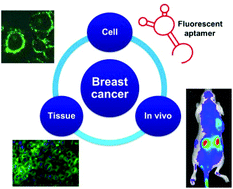Precise discrimination of Luminal A breast cancer subtype using an aptamer in vitro and in vivo†
Abstract
Precise discrimination of breast cancer remains a challenge in clinical medicine, which depends on the development of novel specific molecular probes. However, the current technologies and antibodies cannot achieve precise discrimination of breast cancer subtypes very well. To address this problem, a novel truncated DNA aptamer MF3Ec was developed in this work. Aptamer MF3Ec exhibited high specificity and binding affinity against MCF-7 breast cancer cells with a Kd value of 18.95 ± 2.9 nM which is four times lower than that of the original aptamer, and could work at 4 °C, 25 °C and 37 °C with no obvious differences. Besides, aptamer MF3Ec displayed better stability in serum samples with a long existence time of about 12 h. Moreover, fluorescence imaging experiments indicated that aptamer MF3Ec was able to distinguish MCF-7 breast cancer cells from SK-BR-3, MDA-MB-231 and MCF-10A breast cancer cell subtypes, and differentiate the tumor-bearing mice and xenografted tissue sections of MCF-7 breast cancer cells from those of MDA-MB-231 and SK-BR-3 breast cancer cells in vivo and in vitro, respectively. Finally, clinical experiments indicated that aptamer MF3Ec could distinguish Luminal A breast cancer subtype from Luminal B (HER2+), HER2-enriched, and triple-negative breast cancer subtypes, para-carcinoma tissues and normal breast tissues. Collectively, all these results suggest that aptamer MF3Ec is a promising probe for precise discrimination and targeted therapy of Luminal A breast cancer molecular subtype.



 Please wait while we load your content...
Please wait while we load your content...